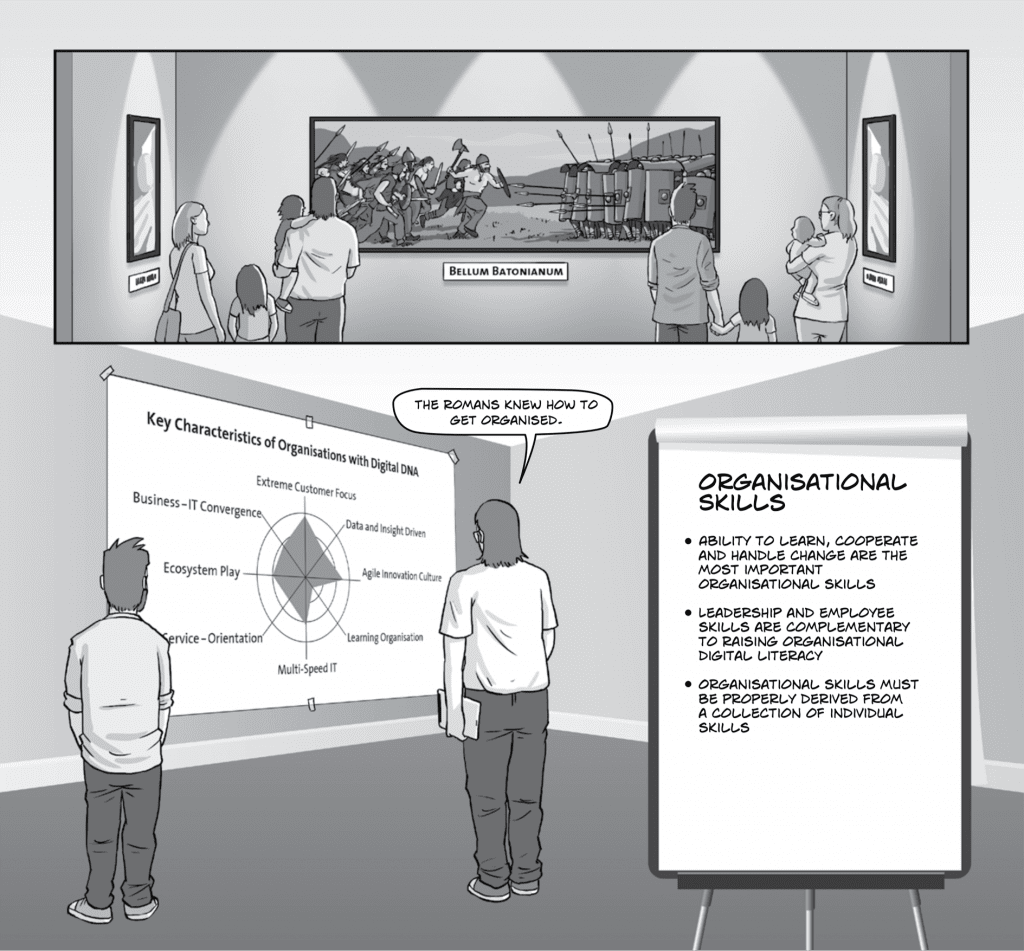‘An organisation’s ability to learn, and translate that learning into action rapidly, is the ultimate competitive advantage’ and ‘Change before you have to’ are two valuable wisdoms worth paying close attention to when thinking about appropriate organisational skills for digital transformation, especially for established businesses.
These high-level organisational skills are so relevant in a digital context because of the swift reaction of the digital customer and rapid enhancements in digital technologies. Incidentally, the above quotes are from Jack Welch, formerly the CEO of General Electric (GE), a visionary and transformational leader. By the end of his tenure in 2001, GE, a company that had evolved from being primarily a ‘product company’ to a ‘service provider’, was the most valuable company of the time by market capitalisation.[1]
Organisational skills are the foundation of capability building, and capabilities with appropriate maturity are essential to initiate and sustain execution of chosen strategies (see Capability Maturity Model Integration [CMMI] for a discourse on capability maturity). While some of the basic concerns, such as cash flow, market capture, pricing, talent acquisition and attrition challenges, remain the same or similar between the ‘old world’ and the ‘digital world’, an organisation with well-developed digital-relevant skills displays certain distinctive attributes, as an organisation and not just through a few of its employees. The chart in the comic strip indicates the most critical skills of the digitally transforming organisation.
In order to exhibit the above skills, two main stakeholders of any company, the leaders and the employees, have to home in on a set of (organisational) skills as well:
Leadership skills: People look up to leaders and tend to follow their example, giving the leaders great opportunity and critical responsibility during any organisational transformation. Conclusions from joint work by MIT and Capgemini[2] are that significantly superior performance of digital organisations has been linked to digital-savvy leadership. Similarly, style and efficacy of leadership engagement has been shown to be a key strategy.[3]
Some of the key skills such successful digital leaders possess are:
- Authentic and engaging communication – Listening ‘at scale’ to a wide variety of stakeholders inside and outside the organisation; frequent, (often) informal and motivating conversations sharing an exciting ambition, clear plans and genuine experiences; engaging through targeted events, participation and personal acts.
- ‘Practice-what-you-preach’ behaviour – Building strong trust and fellowship between the transforming leadership and the rest of the organisation, thus naturally motivating them to follow and contribute with enthusiasm.
- Creating an empowering organisation – Guiding and enabling employees to handle the challenges of operational paradoxes[4],[5] of typical digitally transforming organisations (e.g. standardising vs. empowering, controlling vs. innovating, orchestrating vs. unleashing, agility vs. stability); encouraging a self-learning and experimentation culture; making clear investments in capability development.
- Setting organisational governance of an adaptive and responsive enterprise – Creating flatter organisations and increasing operational flexibility; breaking down ‘silo’ mentality and promoting ‘boundary-less’ collaboration; evolving the right mix of ‘old world’ and ‘digital world’; applying ‘command-and-control’ and ‘commitment-and-coordination’ governance styles appropriately.
Employee skills: Digital-relevant employee skills are the complement to the leadership skills just discussed. Employees, including senior and middle management, either ‘work’ or ‘manage work’. A quick summary of managerial skills in a digital organisation:
- Technology awareness – Keeping abreast of emerging and relevant technologies.
- Analytical mindset – To make sense of large and diverse data inside and outside the company to shape targets and activities; data-driven objective decision-making.
- Driving efficiency and efficacy simultaneously – Using an analytical mindset; ‘Imagineering’ (coined by Disney to train their managers to explore the ‘art of the possible’); using concepts like Design Thinking to incorporate customer empathy in product/service design; combining ‚lean‘ and ‚agile‘ in projects.
- Fostering an open culture – Allowing people to make mistakes as long as they share and capture their learning; an ability to halt failing projects without punishment (for example, Google rewards stoppage of failing or wasteful projects).
Below are the most important digital-relevant employee work and operational skills:
- Adaptability – Embracing and leveraging changes in work and behaviour associated with digital transformation (e.g., creating new opportunities).
- Technology savvy – Eagerly and effectively learning and practising digital tools, technologies and associated methodologies.
- Pioneering mentality – Continually entering new playing fields and testing new products and processes; frequently and constructively challenging the status quo.
- Cross-silo collaboration skills – Assuming incentive compatibility (to be set by management) and proactive collaboration across team and departments.
This section concludes with an important point that is easy to understand, but just as easily overlooked:
‘Individual skills and competencies’ do not necessarily add up to the expected ‘organisational skills and competencies’.
Individuals need motivation to learn new skills; however, from an organisational point of view, such motivations should be accompanied by guidance as to which skills to master and to what level of competency so that they are the most useful for achieving the organisation’s goals. Furthermore, sufficient management attention must be given to producing scalable organisational capabilities by combining individual capabilities – this is often done through appropriate incentive alignment, collaboration and team work and by reinforcing internal structures. It requires a set of deliberate, well thought-out and properly executed leadership skills, together with active management techniques and corresponding employee response, to constructively combine individual capabilities into organisational ones, and in doing so generate the most value for all stakeholders.
_____
[1] General Electric Company: ‘GE Annual Report’, General Electric Company, 2001.
[2] Westerman, G., Bonnet, D., McAfee, A.: ‘Leading Digital: Turning Technology into Business Transformation’, Harvard Business Review Press, 2014.
[3] Li, C.: ‘The Engaged Leader: A Strategy for Your Digital Transformation’, Wharton Digital Press, 2015.
[4] Westerman, G., Bonnet, D., McAfee, A.: ‘Leading Digital: Turning Technology into Business Transformation’, Harvard Business Review Press, 2014.
[5] Aghina, W., De Smet, A., Weerda, K.: ‘Agility: It rhymes with stability’, McKinsey Quarterly, 2015.

